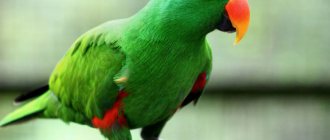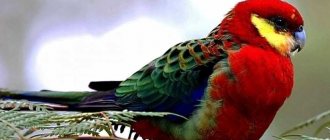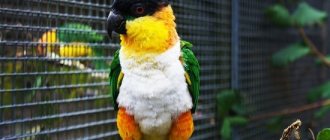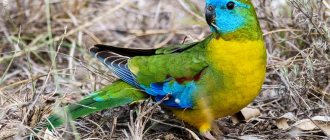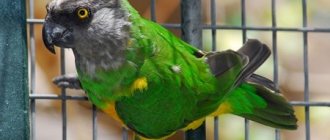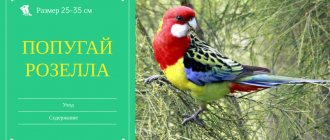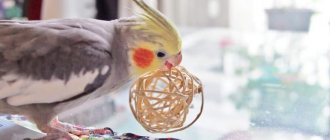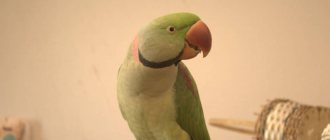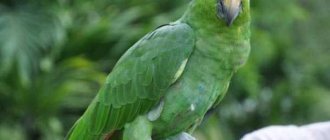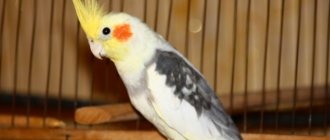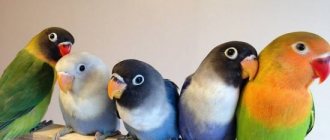Cuban white-headed Amazon (Amazona leucocephala)
Names: White-headed Amazon, Cuban Amazon, Bahamas parrot, Cayman Islands parrot. The size of an adult bird is up to 30 cm. These are stocky and colorful Amazons.
They live naturally in Cuba and the Caribbean islands. They inhabit pine forests, palm groves, mangroves, and wooded areas. They nest in hollows and hollows of trees, with the exception of o. Abaco, where they nest in limestone depressions on the ground.
There are several subspecies: - A. l. leucocephala, lives in eastern Cuba, - A. l. palmarum, lives in western Cuba and about. Juventud, - A. l. caymanensis, lives in the Cayman Islands, - A. l. hesterna, lives in the Cayman Islands, - A. l. bahamensis, lives on the island. Abaco, Great Inagua (Bahamas).
The average lifespan of a Cuban white-headed Amazon is 50-60 years.
These are intelligent and inquisitive birds that easily learn to talk. Adult birds, especially males, become aggressive. Cuban white-crowned Amazons are very active birds, so if they lack exercise, they quickly become fat.
In captivity, Cuban white-headed Amazons are fed a pelleted diet. Fresh vegetables and fruits are added to the granulated food daily. Periodically, the parrots are fed monitor lizard food. When overfed, parrots become very picky eaters. Due to their predisposition to obesity, Amazons are given small quantities of sunflower or safflower seeds (only as a treat). Don't forget to add vitamins and minerals to your birds' diet.
If parrots are fed only seeds, they are additionally given vitamins and minerals to prevent the development of vitamin deficiencies. It is preferable to add vitamins to soft food rather than to water, since water with dissolved vitamins provides a good environment for the development of pathogenic bacteria.
Bathing parrots is vital for their plumage and good skin condition. Birds can be sprayed with fresh water if their feathers become dull. After such a bath, leave the parrot to dry in a warm room or in the sun.
When trimming wings, be careful not to trim the feathers too short, as Cuban white-crowned Amazons often fall and suffer various injuries. Trim only the flight feathers (the first few feathers in the wings), this will be enough for the birds to glide.
Cuban white-headed Amazons are very active; keeping them in captivity requires a fairly spacious cage. You need to create several secret places in the cage where the parrots will hide in case of danger. The ideal cage size should allow parrots to fly freely. The cage must be equipped with reliable and strong locks.
It is desirable that the cage has access to the street so that the birds can spend time in the fresh air and sunbathe. Cuban white-headed Amazons are difficult to breed in captivity. The breeding season occurs in spring and has a limited period: from February or March to June or July. There are usually 3-4 eggs in a clutch. The nest box is placed at a height of 1.2 (or higher) above the bottom of the cage.
There should be two holes in the nest box so that the female can escape from the aggressive male. Wood can be used to build a nest box. The size of the box should be about: 30x30x60 cm.
The incubation period lasts 24-26 days. Chicks begin to fledge at 10-12 weeks of age. Young Amazons are easily tamed.
Where does the Amazon parrot live?
Photo: Venezuelan Amazon parrot
Amazons live near the Amazon River basin. They prefer tropical and subtropical forests with a humid, hot climate. This area is ideal for camouflage - parrots blend in perfectly with their environment.
These parrots also live in the following places:
- Central America;
- South America;
- Antilles.
Amazons are very picky about living conditions at home. An ill-fitting cage or improper perches can harm your bird and expose it to serious chronic illness or even depression.
Interesting fact: It is best not to buy perches in the store, but to find a large branch yourself and process it. It protects your pet from paw diseases that occur due to too narrow perches.
Aviaries are preferable to cages. The parrot should spread its wings comfortably, and the walls of the enclosure will not interfere with it. The bars of the enclosure must be strong, otherwise the parrot will simply bite through them and run away. The cage must have a tray because parrots shed a lot. Feeders should be either made of plastic or more durable materials so that the bird does not bite through them.
Amazons need to communicate and fly. Therefore, you need to let your parrot out of the cage more often so that he can stretch his wings and enjoy walks. Also, if you are not ready to pay enough attention to this bird, you should buy two individuals at once.
Now you know where the Amazon parrot lives. Let's see what this bird eats.
Subspecies of the inhabitants of Liberty Island
Cuban Amazon parrots are divided into five subspecies:
- Cuban (nominated subspecies);
- Bahamian;
- west;
- cayman brac;
- Caymanian
Birds are divided by habitat, size, and coloring characteristics. Thus, the Cuban Amazon, which gave the species its name, lives in the east and central part of Cuba. The body length is usually 32 centimeters (varies from 28 to 34 cm), the predominant color of the plumage is green, white on the forehead and around the eyes. The cheeks, throat, and a small part of the chest are decorated with bright pink feathers, and the ear area is gray.
The parrot has a small lilac spot on its belly, and part of its wing feathers is bright blue. The legs are light brown, the beak is pinkish, the eyes are brown, very dark. Females and young males have little or no blue or pink colors in their plumage.
Description and features of the Amazon parrot
This bird is quite large and densely built. The average length of its body is from 25 to 45 cm, and its weight is 310-480 g. The Amazon parrot in the photo stands out among other parrots with its rich green variegation.
Indeed, its plumage has a bright, rich green color. In some species of these parrots, the green feather is diluted with red feathers on the head, tail or wings. There is more blue color on the back of the head. Amazon's paws are gray.
They have a strong beak of medium length, rounded and with a beak. A sharp rib is clearly visible at its base. The bird's wings are of medium length; they do not reach the end of the tail. The tail of Amazons is not long, slightly rounded.
It is impossible to distinguish a male from a female. You can figure out who is who only during the mating season, when signs of a male courting a female are clearly visible. These birds are characterized by a calm and unforgiving disposition; they are friendly and quickly come into contact with humans. They love affection, but only accept it from a loved one whom they trust.
It is important for those who have decided to acquire this wonderful bird to know that changeability in mood is their individual characteristic. He can run, jump around the cage, and after a couple of minutes sit in it without moving and turn away from everyone. This is normal bird behavior that you just have to put up with.
These parrots also have some negative traits. They almost always require close attention. If they are bored or little attention is paid to them, birds can remind themselves of themselves with a loud cry.
Amazons are practically not afraid of anything. They can show their impudence and commit hooligan acts. To avoid such manifestations in the pet’s behavior, it must be raised when it first appears in the house.
These smart birds will quickly understand what standards of behavior the owner wants from them. The owner, in turn, needs to learn to understand the language of his pet. Its demanding cry for attention is somewhat different from the morning and evening singing.
In nature, these birds constantly have a noisy roll call in the morning and in the evening. They do not deviate from their habits even in captivity. Therefore, people who want to buy an Amazon parrot should immediately be prepared for the fact that silence in their home will be a fairly rare occurrence. In addition to roll call, birds simply love to sing. Their trills can be melodic or not very melodic.
People often wonder: is it possible to teach an Amazon to talk? The answer is clear - yes, these capable birds can learn to speak without problems and in the shortest possible time. Their verbal arsenal can contain up to 50 words.
They can easily learn rhymes and songs. True, everything does not sound as perfect as we would like, but you can still make out the phrases of the birds without difficulty. Sometimes their mistakes in speech lead the hosts and their guests to incredible delight. These parrots can easily copy the meow of a kitten, the sounds of laughter, coughing, doorbells and telephone beeps.
Some owners of these parrots say that their pets can play basketball and even dance. Birds learn best in the morning and evening hours. In no case is it advisable to leave them unattended for the whole day, much less cover the cage for the entire time. Such treatment can cause them stress, which threatens them with nervous ailments.
At the age of five or a little later, Amazons living at home may begin to display aggressive behavior that has not been noticeable until now. This is due to their puberty and the production of large amounts of hormones.
Residents with lemon, red and lilac feathers
The Western Amazon, as the name suggests, lives in the west of Liberty Island. It is the same size as the Cuban, but the green coloring is darker, and instead of pink feathers there are red feathers. It and the Cayman Amazon are not always considered separate subspecies because the distinctive coloring does not appear on all members.
The Cayman Amazon, in turn, is slightly larger - 34 centimeters, green feathers are shaded with a lemon color. Only the forehead is painted white, and the pink color on the cheeks and throat is rather dull. The parrot chose the island of Grand Cayman for its habitat.
The Bahamian Amazon also lives on the islands of the same name. It is distinguished by its lack of lilac color on its belly and a white patch on its head, which is much larger than that of the common Cuban parrot.
The Cayman Brac Amazon is only 30 centimeters long and inhabits the islands of Cayman Brac and Little Cayman. Its plumage is lemon-green in color, the red spots on the front of the neck and cheeks are not connected, and the lilac color on the belly is more noticeable than in other subspecies.
What does the Amazon parrot eat?
Photo: Cuban Amazon Parrot
In the wild, parrots are exclusively herbivores. They eat tree buds, green succulent leaves, fruits, nuts, berries and many other plant foods. They can also eat soft young bark. At home, the diet of these parrots is slightly different from the wild one.
Interesting fact: It is important for Amazons to eat small grains of oats, millet and canary seed. But birds really don’t like it, so ornithologists recommend giving parrots these seeds on spikelets: they peck them with pleasure.
At home, the Amazon diet is as follows:
- sprouted grains;
- porridge on water with honey, but without salt, sugar and butter;
- vegetables, fruits with carotene;
- vegetable purees and juices – suitable for baby food;
- fresh berries in the summer season, dried ones in the winter. Sea buckthorn, rowan, rose hip, cranberry are suitable;
- flowers, rosehip buds, fireweed;
- inflorescences of cherry, apple, lilac and pear.
You need to be careful with protein because Amazons get obesity and many health problems due to this component. Once a week, it is recommended to give a boiled chicken egg and a little low-fat cottage cheese as a calcium supplement.
You can also give young soft bark, which birds happily gnaw on. The branches can even be frozen in the freezer and given in winter, when natural vitamins are extremely scarce. In winter, it is also important to buy plenty of vitamins and nutritional supplements that are sold for large birds.
Life and habits in nature
Cuban Amazons are forest lovers. They live in palm groves, mangroves, and pine forests. They usually nest in tree hollows, but sometimes on the ground, digging holes. These parrots are very curious, sociable, love to explore unfamiliar objects, and are well trained in human speech and onomatopoeia. A bird can remember on average 20-30 words, but there are gifted individuals who memorize up to 100 words and entire phrases.
In nature, Cuban Amazons live in packs consisting of relatives, and during the mating season they create pairs. The breeding season lasts from March to September. The female lays two to five eggs and incubates them for a month. Both parents then take turns flying for food. After 8 weeks, the babies are ready to fly independently.
Population and species status
Amazon parrots are very popular and there are a number of reasons for this. Among other things, these birds reproduce without problems in captivity, which allows the population of this species to remain at a stable level.
These birds are a source of meat for many indigenous people of South America, as well as Australia. These relatively large parrots are used to make soups and stews. Since these are trusting birds, they can be kept as poultry, which is what some tribes do: instead of chickens, they keep Amazon parrots.
Native tribal people often use the colorful feathers of these birds as decorations for their headdresses. To obtain feathers, these parrots are captured and then released. Birds, having lost their feathers and most often their tails, lose their flight properties, so they die because they cannot find food for themselves or become easy prey for predators.
Amazon parrots are prized as pet birds, as they make true family pets. They can be purchased both in pet stores and from private breeders. You can even buy a wild parrot at the market, but this should not be done, as it can pose a certain danger to the owner.
Amazon parrots are distinguished by their friendly nature as well as their playfulness. They love the company of people and can remember human speech, repeating various words and even phrases all the time.
Willful, but amenable to education
Amazon has a unique relationship with humans. The Cuban Amazon is very noisy and you will have to seriously train him so that he does not scream all the time. It must be borne in mind that singing in the early morning and in the evenings is normal. You cannot scold the bird for this; you should treat it with understanding. Indeed, in nature, the Amazon parrot behaves in exactly the same way, arranging a roll call with its relatives twice a day.
Since it is a flocking bird, it needs a lot of communication. The bird must constantly be busy talking or playing, otherwise he may develop a mental disorder. An abandoned, lonely pet is prone to self-destruction. He begins to pluck his feathers and may throw himself at the bars of the cage. Cubans also have mood swings. They can behave impudently, demonstrating to the owner that they are not afraid of him and are not going to take him into account.
Don’t worry: after adaptation to the new place and with the correct patient attitude of the owner, the sharp edges in the bird’s behavior will smooth out. In general, this parrot is friendly, not vindictive, and quickly understands what they want from him.
Price and selection rules
Since parrots of the described breed reproduce poorly in captivity, the cost of the bird is very high and amounts to 500–1000 dollars. You should approach the purchase of a Cuban very carefully, as poachers often try to sell it.
The bird must have the following documents:
- CITES - confirms the legality of purchase and sale;
- test results for diseases such as salmonellosis, psittacosis, bird flu and Newcastle disease;
- certificate issued by a veterinary clinic.
When purchasing, you should also pay attention to the appearance of the bird, which must meet the following parameters:
- feathers fit tightly to the body;
- eyes shine;
- the beak has the correct shape;
- the chest bone does not protrude;
- the parrot breathes evenly and measuredly.
Healthy foods for feeding in captivity
Like other parrots, the Cuban Amazon is given special granular food, to which fruits, vegetables and herbs are added. If you prefer to feed a grain mixture, it should consist of oats, canary grass, millet and wheat. However, when feeding grain, birds must be given vitamin and mineral supplements.
As for fruits and berries, the Cuban Amazon will happily eat apples, any citrus fruits, cherries, bananas, apricots, peaches, gooseberries, melon, currants, raspberries, kiwi, pineapple, strawberries.
Remember that parrots of this species gain weight easily. Obesity is the scourge of Amazons in captivity, causing serious illness and death.
We talk more about nutrition and care in the article “Keeping Amazon parrots using the example of the Venezuelan Amazon.”
Amazon parrot nutrition
The general condition of the pet, its health and ability to bear children depend on proper nutrition. An overweight parrot with a habit of self-plucking can become unhealthy, mentally disturbed and deeply unhappy.
If such a parrot falls into the hands of a caring owner, then there is still every chance to change everything. The main thing is to choose the right diet and necessary food. It is important that the bird receives healthy food. It is better to completely exclude protein-rich foods from her diet - cottage cheese and eggs.
Parrots love meat. But you shouldn’t pamper them with this product. Meat can quickly damage their digestive system and lead to negative and irreversible consequences. This changes the health and appearance of parrots for the worse. The Amazon parrot is one of the few birds that have an appetite even when feeling unwell. They love a high-quality grain mixture consisting of millet, oats, wheat and canary grass.
Of the fruits, these birds like cherries, cherries, apples, oranges, lemons, bananas, limes and tangerines. Among the vegetables they like most are carrots, pumpkin, and cabbage. They love almost all types of berries, as well as nuts and greens. Mineral nutrition should definitely be on the menu of parrots. It is very important to change your birds' water daily.
A rare bird is expensive
The Cuban Amazon is a very rare bird that is in danger of becoming extinct. It reproduces poorly in captivity. It is not surprising that there are few offers for the sale of the parrot, and the price is appropriate - from 500 to 1100 dollars.
When buying a white-headed Amazon, it is worth keeping in mind that it can be poached. Be sure to check the documents: CITES confirming the legality of the purchase and sale, veterinary certificate, test results for avian diseases (salmonellosis, Newcastle disease, avian influenza, psittacosis).
Before taming a bird, you need to give it a week or two to master it. When the parrot gets used to its new home, you can begin active contacts with it.
Did you like the article? Click like and be sure to tell us about your impressions in the comments.
Other species of the genus "Amazon":
- White-fronted Amazon
- Red-tailed Amazon
- Venezuelan Amazon
- Wine-breasted Amazon
- Yellow-headed Amazon
- Yellow-bellied Amazon
- Yellow-shouldered Amazon
- Yellow-bridled Amazon
- Yellow-necked Amazon
- Green-cheeked Amazon
- Imperial Amazon
- Royal Amazon
- Red-browed Amazon
- Red-throated Amazon
- Yellow-cheeked Amazon
- Puerto Rican Amazon
- Luxury Amazon
- Blue-faced Amazon
- Blue-cheeked Amazon
- Blue-capped Amazon
- Soldier's Amazon
- Tucuman Amazon
- Holiday Amazon
- Black-eared Amazon
- Jamaican Black-billed Amazon
- Blue-fronted Amazon
- Suriname Amazon
- Jamaican Yellow-billed Amazon
- Amazon Cavalla
- Amazon Muller
Appearance, dimensions
The Cuban Amazon (Latin name Amazona leucocephala) comes from Cuba and nearby islands - which is how it got its name. In addition, it is also sometimes called the Caribbean and white-headed Amazon. Its dimensions: length 28-34 cm and weight 240-260 grams. Much of the plumage is green, except for the bright pink throat, cheeks, white eye rim, and purple-pink belly. Currently, there are four subspecies that have minor external differences. One subspecies originated in Cuba, two in the Cayman Islands, and one in the Bahamas.
- Amazona leucocephala leucocephala is the nominal subspecies, discovered in 1758. It lives throughout Cuba and the island of Juventud.
- Amazona leucocephala bahamensis - discovered in 1867, now has two habitats: Abaco Island and Great Inagua Island. Visually very similar to the nominate subspecies. The differences are darker plumage, larger spots on the throat and belly.
- Amazona leucocephala caymanensis - lives on the territory of Grand Cayman Island, discovered in 1886. It is slightly larger in size and yellowish-greenish in color.
- Amazona leucocephala hesterna - common in Cayman Brac and the Lesser Cayman Islands, discovered in 1916. It is distinguished by a slightly smaller size, a brighter belly color, and longer spots on the neck and throat.
general description
The Cuban Amazon Amazon leucocephala is a parrot named after its habitat. These birds are common in Cuba and are also found in the Cayman Islands and the Bahamas. Other names for this parrot are Caribbean Amazon and White-headed Amazon.
The parrot is medium in size, the length of the body and tail is from 30 to 35 cm. It has light brown legs and dark brown eyes. The beak is strong, light yellow with a pinkish tint. The tail is short, the plumage under the tail is light green with yellow and red feathers.
The plumage is green with a small black border on the feathers. The feathers around the eyes and on the forehead and tip are white. The throat, cheeks, crop and part of the chest are pinkish-red. The area around the ears and part of the back of the head are gray. The main flight feathers are blue. There is a faint light purple spot on the belly.
The female Cuban Amazon is almost indistinguishable from the male. The chickens do not have a pink spot on their belly, and the pink feathers on the neck and beak area are only slightly marked.
There are 5 known subspecies of Amazon leucocephala, they differ slightly in color and body size:
Amazons are aggressive towards their offspring and can even attack their own offspring. Cuban Amazons are listed in the Red Book, and their catching is officially prohibited. This is one of the most expensive birds; When buying Cuban Amazons, you need to consider how many years they live, so as not to leave an adult bird without an owner.
Keeping at home
Be prepared for this to be a noisy bird. Typically, the peak moments of noise occur in the morning and evening. Like other species of large parrots, it has a high intelligence, so the owner will be faced with the question of how to keep his feathered pet occupied, what games to offer him, and what else can be taught. Otherwise, the bird, deprived of attention, is prone to self-destructive behavior.
If you decide to become the owner of a Cuban Amazon, then you need to pay attention to the durable and spacious models of bird cages in the online store, since such a pet has a strong beak. You will also need to provide him with a large number of all kinds of wooden chewing toys and toys for parrots in order to direct the “gnawing” energy specifically to them, and not to the interior of the apartment. The diet of Cuban Amazons should include a large amount of vegetables and fruits. All well-known manufacturers offer specialized grain mixtures as grain food: Padovan food for large parrots, Versele-Laga Prestige Amazone Parrot PREMIUM, CUNIPIC Parrots, Vitakraft Amazonian and other types.
The Cuban Amazon has a good disposition to learn human speech and is able to remember a large number of words.
Here is a selection of materials that will be useful to future owners:
- Tips for choosing a cage for an Amazon - recommendations are given for choosing a home: minimum dimensions, diameter of rods, requirements for structural elements, specific models of cages that are suitable for this type of bird are also considered.
- Feeding parrots - here we consider the issues of creating a correct and varied diet that can satisfy all the needs of the body, ensure longevity and health.
- How to tame a parrot is the most popular question that arises for new owners. This article describes five steps that will help you tame any bird.
- How to teach a parrot to speak is the second most popular question among bird owners. Let's rephrase it a little - why are some people good teachers and others mediocre? In the material you will learn about seven factors that will help almost anyone turn into a good teacher of human speech.
Home maintenance
The Cuban Amazon is a very noisy parrot that can be a nuisance to those who live with it. He is sociable and inquisitive, prone to imitating sounds and able to learn human speech. The parrot is not very talented, but can learn up to 15 words. Some especially gifted people memorized about 80 words.
To keep a bird, you need to purchase a durable, spacious cage. The parrot loves to explore unknown objects, replacing it with a set of toys from time to time.
A bird needs to communicate; in nature it lives in a flock. If your parrot doesn't exercise, he may become depressed. This condition manifests itself in feather plucking and aggression towards the owner. In general, the Amazon has a capricious disposition, and her behavior can at times irritate the pet owner. He is vengeful and will not miss a single opportunity to take revenge on the offender.
There will be no problems with nutrition; any vegetables and fruits will suffice; you can use ready-made cereal mixtures. Breeding in captivity is extremely rare. Chicks usually need to be bred artificially. If you follow simple rules of care, the Cuban Amazon will live with you as long as nature intended.
Lifestyle in nature
In the wild they have large, noisy bodies. During the breeding season, they form pairs that nest in hollow trees and dry palm trees without foliage. Some subspecies have adapted to nesting in limestone crevices, where they are protected from fire. In their natural habitat they feed on a variety of fruits and seeds, including palm fruits, oranges, and other edible fruits and berries. But for local farmers, this species of bird is a pest that raids rural fields and gardens.
